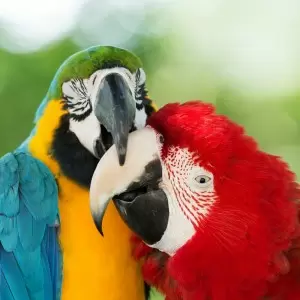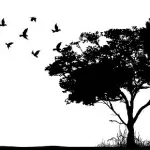
The study of birds, their biology and habits, habitats and evolution and a multitude of other aspects of birds, has a long tradition within the discipline of zoology. There are no degrees in ornithology and most come to the study of birds through a BS/BSc in zoology. Most research-based jobs require at least a Masters level qualification (MS / MSc) and with increasing specialism, a Doctorate. Many people take up ornithology as a hobby, especially tracking migrations and noting population changes throughout the seasons. Bird watching is a keen pastime in the UK for example, and many people in the amateur community carry out vital work in the scientific study of birds - conservation charities are reliant on keen “twitchers”. Charities such as the RSPB, for example, encourage the active participation of bird study and conservation.
History of Ornithology
Before Darwin
We naturally assume that the study of ornithology is a strictly English Victorian pastime, the personal pet projects of such celebrated naturalists and natural historians as Gilbert White, Thomas Bewick, George Montagu, Richard Jefferies - and of course, Charles Darwin. These highly noteworthy figures and others like them contributed massively to the study of a great many aspects of natural history, but we need to look back further than them to see the beginnings of ornithology. Aristotle first took up the mantle of the study of birds (1) though it would be a long time coming before the discipline would become a science as we might have understood it. The Renaissance saw a period of splitting between natural history and classification. From there it became highly specialised (2) with two seminal early publications: Ornithology and Wisdom both by John Ray (but the first book initially had input from Francis Willughby who died while the men were recording their observations and compiling their book).
Eventually, the two strands would come back together again; classification in itself - and the production of ornithology encyclopaedias that were popular during the renaissance - would only have limited scope and the scientific naming and classification conventions are no longer separate entities (1). Colonialism of the 18th and 19th century have English, Dutch and French naturalists access to a much broader range of native birds (2). Whether shipped into their adopted countries for study, or whether the naturalist was able to travel abroad, this was a Golden Age of the science of ornithology and led to great cooperation. It became more rigorous - it became a true science. It was one particular journey that would change much more than the course of a scientific discipline - that of Charles Darwin's aboard The Beagle and it would provide the most ground-breaking work in the history of biology.
Darwin and Later
Charles Darwin's work and its importance to science of the study of birds cannot be underestimated today. Darwin based much of his early understanding of evolutionary theory on the study of birds (1). His analysis of the form and evolution of Galapagos Finches for example is very well recorded for the theory of speciation by environment (3, p66-67) and later his study of pigeons was powerful evidence for sexual selection (3, p71). Once Darwin's theory of Natural Selection and Sexual Selection were accepted in the first half of the 20th century, the modern scientific discipline of ornithology took shape (1). Interestingly, some of Darwin's earliest critics included his fellow naturalists whose primary interest was in ornithology (3, p66).
The two strands created by John Ray came back together again with the publication of work by Erwin Stresemann (2) and the acceptance of Evolutionary Theory within the discipline (1). Like Darwin, Stresemann travelled extensively in the eastern islands (4) and he took the broadest possible interest in the discipline, including taxonomy (a remarkable achievement considering by the time he entered the discipline most of the world's then-known birds were already classified) (5, p147). His interest in both the natural evolution and development of birds arguably set the science on the road it is on today. Despite being early critics of Darwin, Ornithologists are said to be amongst the first to test and then accept his theory (1), paving the way for other divisions of zoology to accept it, leading to the rise of evolutionary biology as a science in itself. Perhaps ahead of his time, Streseman realised that birds were the perfect life form for the study of ecology and adaptation (4).
What Can Ornithology Teach Us?
Endangered Species
There is of course, much interest in birds for the sake of interest in birds, and as indicators of evolutionary development as stated above, but there is far more that they can tell us about our environment, about humanity. In the last couple of centuries, some of the most notable extinctions in the animal kingdom have been birds. The dodo is the most famous and it disappeared due to over-hunting, habitat loss and competition of introduced species (6) disappearing from the world shortly before dawn of the 18th century (7). We know so little about its physiology, and not much about its preferred habitats, and to limit or avoid future extinctions, it is important that we do so for other threatened species. Another famous extinction is that of the Great Auk. Fishing and hunting brought to extinction a bird that was once a prevalent flightless bird right across the North Atlantic area (8).
These two show the potential damage that humans represent to animal species in the world today. In this respect, it is important to research animal species to understand how we might help them adapt to climate change, and to human expansion threatening their habitats. Causing extinction of species, particularly on island habitats, is not limited to the modern industrial and capitalist era though. In the East Indies, where Darwin would travel, several recently identified species have a notable and clear decline following the migration of humans, quickly becoming extinct after thousands of years (15) (16).
Environment
The flipside of this is what the study of birds can tell us about the environment. The study of birds, their migration and numbers, evolving patterns of breeding and settling can not only tell us about the birds themselves, but also about their preferences for environmental conditions. This fuels much of the research of important ornithological charities such as the UK's RSPB (Royal Society for the Protection of Birds). Noting that Hen Harriers are in decline in England, and for the first time in 2013 they failed to nest in England despite having a lot of natural habitat in conservation (9). DEFRA has put together a comprehensive framework for their conservation (10). It is a matter of discussion whether the bird is reaction to preferred territory or environmental pressures (13, p260). For others, that question is simply too big and broad to answer in isolation. There are many elements in why birds prefer certain conditions and later adapt to somewhere else: natural evolution? Or are there other forcings such as aggressive competition, invading species (11, p160) or something else? Aggressive behaviour by other species can be an indication of environmental change for example, if a previously abundant resource is suddenly limited (natural processes such as drought and flood can enormously impact a food supply that an ecosystem has come to rely on).
Studies in recent years have shown that bird numbers and migration patterns (and the changes) can demonstrate to us the changing biodiversity of certain areas. Birds exist in every identifiable ecosystem on the planet and are therefore one of the first species to react to a changing local environment (12, p11 & p22). Many species of bird live in areas that are often subject to temperamental weather conditions (13, p260) - wetlands are a prime example of this and Europe's rich history of drainage provides a vital record to environmental change. Researchers then have to take extreme care to understand what the environmental pressure might be - whether it is temporary or long-term issue and whether population density is likely to change. Fluctuations are likely to have a range of causes (13, p265) so using birds as an indicator of biodiversity and environmental change needs to factor in a great many issues, and should be taken on a case by case basis, before formulating a conclusion.
The Human Past
Humans have always utilised animals as a resource; they are as much of our own cultural and social development as the crops we have cultivated, the livestock we have farmed (or hunted), and how we have used and shaped the environment - and the resources - around us. The study of animals in relation to humans in the past is called zooarchaeology. The discipline is a subset of archaeology but takes much from - and offers much to - ornithology. It concerns itself largely with the following aspects:
- Which animals were used as resources (eaten, for skin, for bones etc)
- Who did the work of hunting, working the bone, skinning, plucking etc of the animals
- The influence that the animals had on culture (in terms of diet, whether the animals were considered cultural icons - objects of veneration etc)
- The prevalence of certain animal species can tell us about the environment at the time
These are interesting questions for all animal species, and birds play a major part in the understanding of animals' association with humans in the past. Hunting of wildfowl was a daily occurrence, arguably far less resource-intense than hunting larger fauna where a hunt may have needed strategic planning. This less intense and less dangerous practice for humans to obtain a food source could be the major reason behind several extinctions of bird populations in antiquity (15) (16).
Birds have been an abundant wild resource for almost as long as humanity has been around and, at times, they have formed the core of our diet. It is known from discard pits that monastic orders in Europe ate plenty of eggs from domesticated chickens and the meat because of the strictures against meat (birds were not considered meat) (14, p45). Animal bones often survive very well as they are placed into rubbish pits and sealed so we can learn. What this tells us is not just about the birds that were utilised, but also to what extent they were used, and how prevalent they were in certain areas. This is useful for plotting environmental change - natural and human impacts. For example, we would expect to see different bird species in an area that was once a wetland, but is later drained. The make-up of bird species is likely to change.
Identifying the bone structures through ornithology can tell us a lot about the changing environment and migrations in the past so we can better understand modern bird populations, habits and morphology.
Learn about how to become an ornithologist.
Sources
- http://www.els.net/WileyCDA/ElsArticle/refId-a0003096.html
- https://onlinelibrary.wiley.com/doi/full/10.1002/9780470015902.a0003096
- http://www.thomas-junker.homepage.t-online.de/pdf/03tjas.pdf
- http://onlinelibrary.wiley.com/doi/10.1111/j.1474-919X.1973.tb02647.x/pdf
- Westerskov, K.E. 1976: Professor Erwin Stresemann and his contribution to Australasian Ornithology. Notornis 23, (2) p139-160 (http://notornis.osnz.org.nz/system/files/Notornis_23_2.pdf)
- http://www.nhm.ac.uk/nature-online/species-of-the-day/collections/curation/raphus-cucullatus/index.html
- https://www.nature.com/articles/426245a
- http://www.nhm.ac.uk/nature-online/collections-at-the-museum/museum-treasures/great-auk/index.html
- http://www.rspb.org.uk/joinandhelp/donations/campaigns/hen-harrier-appeal/index.aspx
- http://jncc.defra.gov.uk/page-5775
- http://sora.unm.edu/sites/default/files/journals/wilson/v076n02/p0160-p0169.pdf
- http://132.248.13.1/directorio/r/d_renton/pdf/22.pdf
- http://www.sciencemag.org/content/267/5201/1123
- Guide to Parasitology - November 19, 2018
- Deserts as Ecosystems and Why They Need Protecting - November 19, 2018
- Conservation: History and Future - September 14, 2018
Related Articles
Featured Article

Fracking: What Is It and How Will It Affect You?





